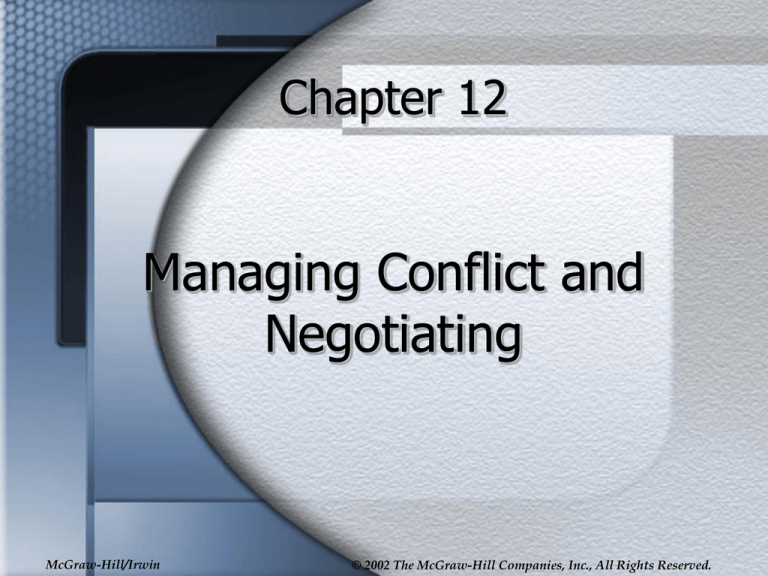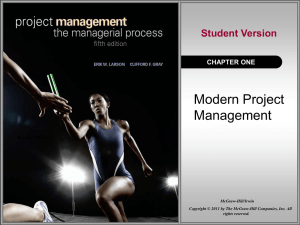
Chapter 12
Managing Conflict and
Negotiating
McGraw-Hill/Irwin
© 2002 The McGraw-Hill Companies, Inc., All Rights Reserved.
11-1a
Chapter 12 Outline
A Modern View of Conflict
•A Conflict Continuum
•Functional versus Dysfunctional Conflict
•Antecedents of Conflict
•Desired Outcomes of Conflict
Major Sources of Conflict
•Personality Conflicts
•Inter-group Conflict
•Cross-Cultural Conflict
McGraw-Hill/Irwin
© 2002 The McGraw-Hill Companies, Inc., All Rights Reserved.
11-1b
Chapter Eleven Outline (continued)
Managing Conflict
• Programming Functional Conflict
• Alternative Styles for Handling Dysfunctional Conflict
• Third-Party Interventions: Alternative Dispute
Resolution
Negotiating
• Two Basic Types of Negotiation
• Added-Value Negotiation
McGraw-Hill/Irwin
© 2002 The McGraw-Hill Companies, Inc., All Rights Reserved.
11-2
Conflict
Conflict: “A process in which one party perceives that its
interests are being opposed or negatively affected by another
party.”
Functional conflict serves the
organization’s interests while
dysfunctional conflict threatens
the organization’s
interests.
McGraw-Hill/Irwin
© 2002 The McGraw-Hill Companies, Inc., All Rights Reserved.
11-3a
Antecedents of Conflict
•
•
•
•
•
•
•
Incompatible personalities or value systems.
Overlapping or unclear job boundaries.
Competition for limited resources.
Interdepartment/intergroup competition.
Inadequate communication.
Interdependent tasks.
Organizational complexity.
McGraw-Hill/Irwin
© 2002 The McGraw-Hill Companies, Inc., All Rights Reserved.
11-3b
Antecedents of Conflict (continued)
•
•
•
•
•
•
Unreasonable or unclear policies, standards, or
rules.
Unreasonable deadlines or extreme time pressure.
Collective decision making.
Decision making by consensus.
Unmet expectations.
Unresolved or suppressed conflict.
McGraw-Hill/Irwin
© 2002 The McGraw-Hill Companies, Inc., All Rights Reserved.
11-4
Desired Outcomes of Conflict
Agreement: Strive for equitable and fair agreements that
last.
Stronger relationships: Build bridges of goodwill and
trust for the future.
Learning: Greater self-awareness and creative problem
solving.
McGraw-Hill/Irwin
© 2002 The McGraw-Hill Companies, Inc., All Rights Reserved.
11-5
Tips for Managers Whose Employees Are
Having a Personality Conflict
1.
2.
3.
4.
5.
Follow company policies for diversity, antidiscrimination, and sexual harassment.
Investigate and document conflict.
If appropriate, take corrective action (e.g.,
feedback or B Mod).
If necessary, attempt informal dispute
resolution.
Refer difficult conflicts to human resource
specialists or hired counselors for formal
resolution attempts and other interventions.
McGraw-Hill/Irwin
© 2002 The McGraw-Hill Companies, Inc., All Rights Reserved.
11-6
Figure 11-1
Minimizing Inter-group Conflict: An
Updated Contact Model
Level of perceived
Inter-group conflict tends
to increase when:
• Conflict within the
group is high
• There are negative
interactions between
groups (or between
members of those
groups)
• Influential third-party
gossip about other group
is negative
McGraw-Hill/Irwin
Recommended actions:
• Work to eliminate specific negative
interactions between groups (and
members).
• Conduct team building to reduce
intragroup conflict and prepare
employees for cross-functional teamwork.
• Encourage personal friendships and
good working relationships across
groups and departments.
• Foster positive attitudes toward
members of other groups (empathy,
compassion, sympathy).
• Avoid or neutralize negative gossip
across groups or departments.
© 2002 The McGraw-Hill Companies, Inc., All Rights Reserved.
11-7
Skills and Best Practices: How to
Build Cross-Cultural Relationships
Behavior
Rank
Be a good listener
Be sensitive to the needs of others
Be cooperative, rather than overly competitive
Advocate inclusive (participative) leadership
Compromise rather than dominate
Build rapport through conversations
Be compassionate and understanding
Avoid conflict by emphasizing harmony
Nurture others (develop and mentor)
McGraw-Hill/Irwin
1
2
2
3
4
5
6
7
8
Tie
© 2002 The McGraw-Hill Companies, Inc., All Rights Reserved.
11-8
Figure 11-2
Concern for Others
Five Conflict-Handling Styles
High
Integrating
Obliging
Compromising
Low
Dominating
Avoiding
High
Low
Concern for Self
Source: MA Rahim, “A Strategy for Managing Conflict in Complex Organizations, Human Relations, January
1985, p 84. Used with author’s permission.
McGraw-Hill/Irwin
© 2002 The McGraw-Hill Companies, Inc., All Rights Reserved.
11-9
Hands on
Exercise
What is your Conflict-Handling Style?
•How important are conflict-handling skills in the modern
workplace? Explain.
• Did this instrument do a reasonable good job of identifying
your primary and backup conflict-handling styles? Explain.
•Do you need to improve your conflict-handling skills? Explain.
• In your opinion, which conflict-handling style would tend to
be most successful in today’s workplace? Which is the least
successful?
•What is your experience with managers who had dysfunctional
conflict-handling styles? What was the impact on work
motivation and job satisfaction?
McGraw-Hill/Irwin
© 2002 The McGraw-Hill Companies, Inc., All Rights Reserved.
11-10
Alternative Dispute Resolution (ADR)
Techniques
Facilitation: Third party gets disputants to deal directly and
constructively with each other.
Conciliation: Neutral third party acts as communication link
between disputants.
Peer review: Impartial co-workers hear both sides and render
decision that may or may not be binding.
Ombudsman: Respected and trusted member of the
organization hears grievances confidentially.
Mediation: Trained third-party guides disputants toward their
own solution.
Arbitration: Neutral third-party hears both sides in a court-like
setting and renders a binding decision.
McGraw-Hill/Irwin
© 2002 The McGraw-Hill Companies, Inc., All Rights Reserved.
11-11
Negotiating
Negotiation: “A give-and-take decision-making process
involving interdependent parties with different preferences.”
Distributive negotiation: Single issue; fixed-pie; win-lose.
Integrative negotiation: More than one issue; win-win.
McGraw-Hill/Irwin
© 2002 The McGraw-Hill Companies, Inc., All Rights Reserved.
11-12
An Integrative Approach:
Added-Value Negotiation
McGraw-Hill/Irwin
Clarify interests.
Identify options.
Design alternative deal packages.
Select a deal.
Perfect the deal.
© 2002 The McGraw-Hill Companies, Inc., All Rights Reserved.





